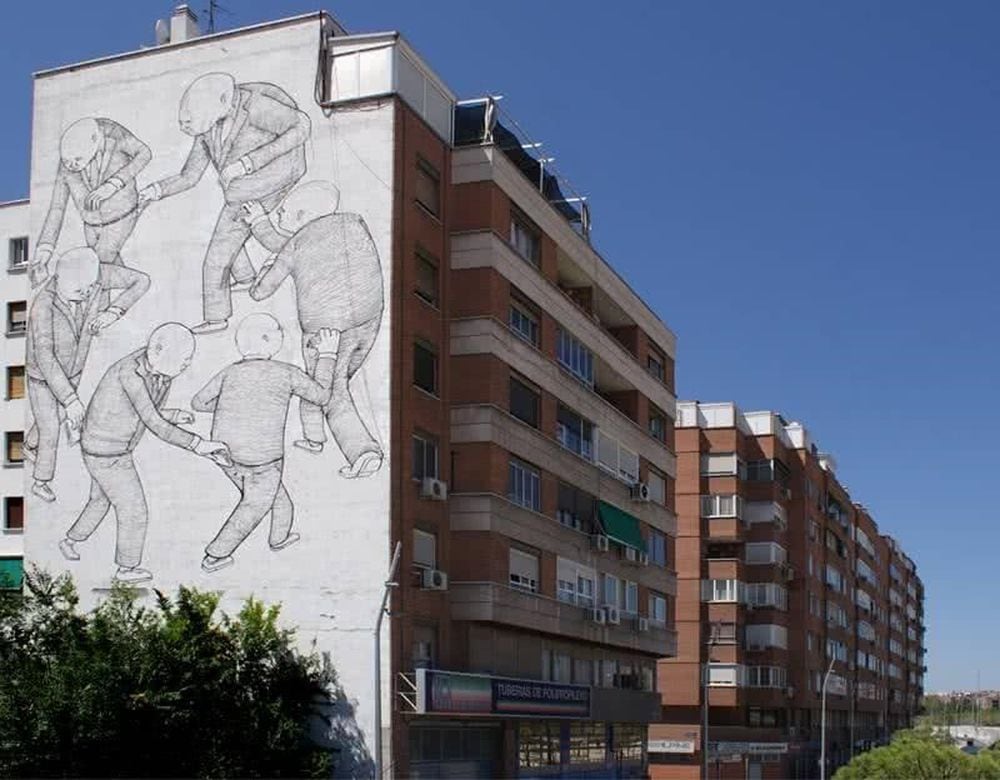The iconic mural that the Italian artist Blu painted in Madrid in 2010 has definitely disappeared. After more than a decade opening the urban art route on one of the banks of the Manzanares, the building used as a canvas by this Bolognese artist, one of the pioneers of urban art in the capital, has undergone a reform that has ended the work . The community of residents of the block, in front of the Plaza Río 2 shopping center, once gave the space to the artist to claim urban art. It was precisely the owners of the building who have decided that the mural should be erased, municipal sources have confirmed, who have recalled that it was a private wall.
Strolling through Madrid Río, on one of the banks of the Manzanares, the mural stood on a dividing wall of a six-story residential building, made unique thanks to the beauty of the work. It was a drawing that represented several individuals who steal each other’s wallets creating a circle, and which had already become one more piece of the urban landscape of the Usera district and a mandatory stop on guided tours of street art by the city.
The community of residents of this property, located on the corner of Avenida del Manzanares and Eugenio Caxes, received an execution order from the City Council last year due to a problem of detachments in the plastering of the building. Taking advantage of the reform, which is still underway ―as witnessed by the scaffolding still placed on the main facade―, the neighbors agreed fix also the side that Blu used as the canvas for his mural, and which now shows off a pristine white except for some recently scribbled graffiti.
The work had been there since September 2010, when the neighborhood community gave its facade to the artist so that he could make his mural as part of a pioneering municipal initiative to enhance urban art. It has lasted just 10 years and two months, since last November 2020 the works that caused its disappearance began.
“Taking advantage of the fact that the hanging was going to be done, it was decided to also fix that facade because it was cracked and in poor condition. The job of painting the façade while maintaining the drawing was very expensive, something unaffordable for the community of neighbors, ”explain community sources.
Blu’s mural accompanied three other murals painted by the urban artist Sam3, and which drew an artistic journey along the Manzanares River that could be seen walking through Madrid Río. That of the Italian was the first mural if you started your journey along the river walk near Matadero, in Legazpi. “That mural was a very important reference in muralism for the last 20 years. Blu is someone who also has a very peculiar profile because most of his works have a deeply social and critical content, ”explains Guillermo de la Madrid, an expert in urban art.
Blu, whose real identity is unknown even in the circles of the street art, has had two other murals in Madrid. One was in the field of La Cebada next to the La Latina Metro, already destroyed to build a sports center, and another in Lavapiés that represents a shield of the city with the bear and the strawberry tree in which two workers cut down the characteristic tree of Madrid .
On the finitude of urban art, Guillermo de la Madrid acknowledges that “there is a certain reflection in the world”, since “when the murals began to be made, he did not consider what was going to happen in 10 years”. And it is that “there are artists who say I make my mural and understand that it is subject to the passage of time, to the climate and it will disappear”, although he is committed to preserving those who, in some way, have left their mark on the cities.
Since the destruction of this iconic mural to which walkers and residents of Madrid Río and the Usera district had already become accustomed, tourist guides who take urban art tours through Madrid will have to change their routes and omit one of their visits from the most recognized murals in the capital.
–

